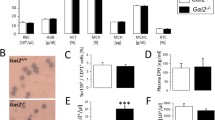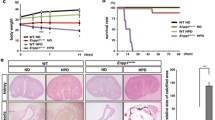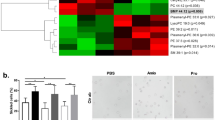Abstract
Klotho, a membrane protein mainly expressed in parathyroid glands, kidney, and choroid plexus, counteracts aging and increases the life span. Accordingly, life span is significantly shorter in Klotho-deficient mice (klotho −/−) than in their wild-type littermates (klotho +/+). The pleotropic effects of Klotho include inhibition of 1,25-dihydroxyvitamin D3 (1,25(OH)2D3) formation. Vitamin D-deficient diet reverses the shortening of life span in klotho −/− mice. In a variety of cells, 1,25(OH)2D3 stimulates Ca2+ entry. In erythrocytes, increased Ca2+ entry stimulates suicidal erythrocyte death, which is characterized by cell shrinkage and phosphatidylserine exposure at the erythrocyte surface. The present study explored the putative impact of Klotho on eryptosis. According to Fluo3 fluorescence, cytosolic Ca2+ concentration was significantly larger in klotho −/− erythrocytes as compared to klotho +/+ erythrocytes. According to annexin V-binding, phosphatidylserine exposure was significantly enhanced, and according to forward scatter, cell volume significantly decreased in klotho −/− erythrocytes as compared to klotho +/+ erythrocytes. Energy depletion (13 h glucose depletion) and oxidative stress (35 min 1 mM tert-butyl-hydroxyl-peroxide [tert-BOOH]) increased phosphatidylserine exposure to values again significantly larger in klotho −/− erythrocytes as compared to klotho +/+ erythrocytes. Reticulocyte number was significantly increased in klotho −/− mice, pointing to enhanced erythrocyte turnover. Vitamin D-deficient diet reversed the enhanced Ca2+ entry and annexin V-binding of klotho −/− erythrocytes. The present observations reveal a novel function of Klotho, i.e., the at least partially vitamin D-dependent regulation of cytosolic Ca2+ activity in and suicidal death of erythrocytes.






Similar content being viewed by others
References
Andrews DA, Low PS (1999) Role of red blood cells in thrombosis. Curr Opin Hematol 6:76–82
Bentzen PJ, Lang E, Lang F (2007) Curcumin induced suicidal erythrocyte death. Cell Physiol Biochem 19:153–164
Berg CP, Engels IH, Rothbart A, Lauber K, Renz A, Schlosser SF, Schulze-Osthoff K, Wesselborg S (2001) Human mature red blood cells express caspase-3 and caspase-8, but are devoid of mitochondrial regulators of apoptosis. Cell Death Differ 8:1197–1206
Boas FE, Forman L, Beutler E (1998) Phosphatidylserine exposure and red cell viability in red cell aging and in hemolytic anemia. Proc Natl Acad Sci U S A 95:3077–3081
Bolanz KA, Hediger MA, Landowski CP (2008) The role of TRPV6 in breast carcinogenesis. Mol Cancer Ther 7:271–279
Bookchin RM, Ortiz OE, Lew VL (1987) Activation of calcium-dependent potassium channels in deoxygenated sickled red cells. Prog Clin Biol Res 240:193–200
Brand VB, Sandu CD, Duranton C, Tanneur V, Lang KS, Huber SM, Lang F (2003) Dependence of plasmodium falciparum in vitro growth on the cation permeability of the human host erythrocyte. Cell Physiol Biochem 13:347–356
Bratosin D, Estaquier J, Petit F, Arnoult D, Quatannens B, Tissier JP, Slomianny C, Sartiaux C, Alonso C, Huart JJ, Montreuil J, Ameisen JC (2001) Programmed cell death in mature erythrocytes: a model for investigating death effector pathways operating in the absence of mitochondria. Cell Death Differ 8:1143–1156
Brugnara C, de Franceschi L, Alper SL (1993) Inhibition of Ca(2+)-dependent K+ transport and cell dehydration in sickle erythrocytes by clotrimazole and other imidazole derivatives. J Clin Invest 92:520–526
Christakos S, Dhawan P, Benn B, Porta A, Hediger M, Oh GT, Jeung EB, Zhong Y, Ajibade D, Dhawan K, Joshi S (2007) Vitamin D: molecular mechanism of action. Ann N Y Acad Sci 1116:340–348
Closse C, Dachary-Prigent J, Boisseau MR (1999) Phosphatidylserine-related adhesion of human erythrocytes to vascular endothelium. Br J Haematol 107:300–302
Daugas E, Cande C, Kroemer G (2001) Erythrocytes: death of a mummy. Cell Death Differ 8:1131–1133
Dekkers DW, Comfurius P, Bevers EM, Zwaal RF (2002) Comparison between Ca2+-induced scrambling of various fluorescently labelled lipid analogues in red blood cells. Biochem J 362:741–747
Duranton C, Huber S, Tanneur V, Lang K, Brand V, Sandu C, Lang F (2003) Electrophysiological properties of the plasmodium falciparum-induced cation conductance of human erythrocytes. Cell Physiol Biochem 13:189–198
Duranton C, Huber SM, Lang F (2002) Oxidation induces a Cl(−)-dependent cation conductance in human red blood cells. J Physiol 539:847–855
Fadok VA, Bratton DL, Rose DM, Pearson A, Ezekewitz RA, Henson PM (2000) A receptor for phosphatidylserine-specific clearance of apoptotic cells. Nature 405:85–90
Foller M, Feil S, Ghoreschi K, Koka S, Gerling A, Thunemann M, Hofmann F, Schuler B, Vogel J, Pichler B, Kasinathan RS, Nicolay JP, Huber SM, Lang F, Feil R (2008) Anemia and splenomegaly in cGKI-deficient mice. Proc Natl Acad Sci U S A 105:6771–6776
Foller M, Shumilina E, Lam R, Mohamed W, Kasinathan R, Huber S, Chakraborty T, Lang F (2007) Induction of suicidal erythrocyte death by listeriolysin from listeria monocytogenes. Cell Physiol Biochem 20:1051–1060
Gallagher PG, Chang SH, Rettig MP, Neely JE, Hillery CA, Smith BD, Low PS (2003) Altered erythrocyte endothelial adherence and membrane phospholipid asymmetry in hereditary hydrocytosis. Blood 101:4625–4627
Gonzalez-Sancho JM, Larriba MJ, Ordonez-Moran P, Palmer HG, Munoz A (2006) Effects of 1alpha,25-dihydroxyvitamin D3 in human colon cancer cells. Anticancer Res 26:2669–2681
Huber SM, Gamper N, Lang F (2001) Chloride conductance and volume-regulatory nonselective cation conductance in human red blood cell ghosts. Pflugers Arch 441:551–558
Imura A, Iwano A, Tohyama O, Tsuji Y, Nozaki K, Hashimoto N, Fujimori T, Nabeshima Y (2004) Secreted klotho protein in sera and CSF: implication for post-translational cleavage in release of klotho protein from cell membrane. FEBS Lett 565:143–147
Imura A, Tsuji Y, Murata M, Maeda R, Kubota K, Iwano A, Obuse C, Togashi K, Tominaga M, Kita N, Tomiyama K, Iijima J, Nabeshima Y, Fujioka M, Asato R, Tanaka S, Kojima K, Ito J, Nozaki K, Hashimoto N, Ito T, Nishio T, Uchiyama T, Fujimori T, Nabeshima Y (2007) alpha-klotho as a regulator of calcium homeostasis. Science 316:1615–1618
Ishizawa M, Matsunawa M, Adachi R, Uno S, Ikeda K, Masuno H, Shimizu M, Iwasaki K, Yamada S, Makishima M (2008) Lithocholic acid derivatives act as selective vitamin D receptor modulators without inducing hypercalcemia. J Lipid Res 49:763–772
Kempe DS, Lang PA, Duranton C, Akel A, Lang KS, Huber SM, Wieder T, Lang F (2006) Enhanced programmed cell death of iron-deficient erythrocytes. FASEB J 20:368–370
Klarl BA, Lang PA, Kempe DS, Niemoeller OM, Akel A, Sobiesiak M, Eisele K, Podolski M, Huber SM, Wieder T, Lang F (2006) Protein kinase C mediates erythrocyte “programmed cell death” following glucose depletion. Am J Physiol Cell Physiol 290:C244–C253
Kuro-o M, Matsumura Y, Aizawa H, Kawaguchi H, Suga T, Utsugi T, Ohyama Y, Kurabayashi M, Kaname T, Kume E, Iwasaki H, Iida A, Shiraki-Iida T, Nishikawa S, Nagai R, Nabeshima YI (1997) Mutation of the mouse klotho gene leads to a syndrome resembling ageing. Nature 390:45–51
Kurosu H, Yamamoto M, Clark JD, Pastor JV, Nandi A, Gurnani P, McGuinness OP, Chikuda H, Yamaguchi M, Kawaguchi H, Shimomura I, Takayama Y, Herz J, Kahn CR, Rosenblatt KP, Kuro-o M (2005) Suppression of aging in mice by the hormone klotho. Science 309:1829–1833
Lang F, Gulbins E, Lerche H, Huber SM, Kempe DS, Föller M (2008) Eryptosis, a window to systemic disease. Cell Physiol Biochem 22:373–380
Lang KS, Duranton C, Poehlmann H, Myssina S, Bauer C, Lang F, Wieder T, Huber SM (2003) Cation channels trigger apoptotic death of erythrocytes. Cell Death Differ 10:249–256
Lang KS, Lang PA, Bauer C, Duranton C, Wieder T, Huber SM, Lang F (2005) Mechanisms of suicidal erythrocyte death. Cell Physiol Biochem 15:195–202
Lang KS, Myssina S, Tanneur V, Wieder T, Huber SM, Lang F, Duranton C (2003) Inhibition of erythrocyte cation channels and apoptosis by ethylisopropylamiloride. Naunyn Schmiedebergs Arch Pharmacol 367:391–396
Lang PA, Kaiser S, Myssina S, Wieder T, Lang F, Huber SM (2003) Role of Ca2+-activated K+ channels in human erythrocyte apoptosis. Am J Physiol Cell Physiol 285:C1553–C1560
Lang PA, Warskulat U, Heller-Stilb B, Huang DY, Grenz A, Myssina S, Duszenko M, Lang F, Haussinger D, Vallon V, Wieder T (2003) Blunted apoptosis of erythrocytes from taurine transporter deficient mice. Cell Physiol Biochem 13:337–346
Luong QT, Koeffler HP (2005) Vitamin D compounds in leukemia. J Steroid Biochem Mol Biol 97:195–202
Martinesi M, Treves C, d'Albasio G, Bagnoli S, Bonanomi AG, Stio M (2008) Vitamin D derivatives induce apoptosis and downregulate ICAM-1 levels in peripheral blood mononuclear cells of inflammatory bowel disease patients. Inflamm Bowel Dis 14:597–604
Myrthue A, Rademacher BL, Pittsenbarger J, Kutyba-Brooks B, Gantner M, Qian DZ, Beer TM (2008) The Iroquois Homeobox gene 5 Is regulated by 1,25-dihydroxyvitamin D3 in human prostate cancer and regulates apoptosis and the cell cycle in LNCaP prostate cancer cells. Clin Cancer Res 14:3562–3570
Nabeshima Y (2006) Toward a better understanding of Klotho. Sci Aging Knowl Environ 2006(8):pe11
Nicolay JP, Gatz S, Liebig G, Gulbins E, Lang F (2007) Amyloid induced suicidal erythrocyte death. Cell Physiol Biochem 19:175–184
Niemoeller OM, Foller M, Lang C, Huber SM, Lang F (2008) Retinoic acid induced suicidal erythrocyte death. Cell Physiol Biochem 21:193–202
Orrenius S, Zhivotovsky B, Nicotera P (2003) Regulation of cell death: the calcium-apoptosis link. Nat Rev Mol Cell Biol 4:552–565
Pedersen LB, Nashold FE, Spach KM, Hayes CE (2007) 1,25-dihydroxyvitamin D3 reverses experimental autoimmune encephalomyelitis by inhibiting chemokine synthesis and monocyte trafficking. J Neurosci Res 85:2480–2490
Razzaque MS, Sitara D, Taguchi T, St Arnaud R, Lanske B (2006) Premature aging-like phenotype in fibroblast growth factor 23 null mice is a vitamin D-mediated process. FASEB J 20:720–722
Renkema KY, Alexander RT, Bindels RJ, Hoenderop JG (2008) Calcium and phosphate homeostasis: concerted interplay of new regulators. Ann Med 40:82–91
Schneider J, Nicolay JP, Foller M, Wieder T, Lang F (2007) Suicidal erythrocyte death following cellular K+ loss. Cell Physiol Biochem 20:35–44
Shimada T, Kakitani M, Yamazaki Y, Hasegawa H, Takeuchi Y, Fujita T, Fukumoto S, Tomizuka K, Yamashita T (2004) Targeted ablation of Fgf23 demonstrates an essential physiological role of FGF23 in phosphate and vitamin D metabolism. J Clin Invest 113:561–568
Sun X, Zemel MB (2007) 1Alpha,25-dihydroxyvitamin D3 modulation of adipocyte reactive oxygen species production. Obesity (Silver Spring) 15:1944–1953
Takeshita K, Fujimori T, Kurotaki Y, Honjo H, Tsujikawa H, Yasui K, Lee JK, Kamiya K, Kitaichi K, Yamamoto K, Ito M, Kondo T, Iino S, Inden Y, Hirai M, Murohara T, Kodama I, Nabeshima Y (2004) Sinoatrial node dysfunction and early unexpected death of mice with a defect of klotho gene expression. Circulation 109:1776–1782
Topala CN, Bindels RJ, Hoenderop JG (2007) Regulation of the epithelial calcium channel TRPV5 by extracellular factors. Curr Opin Nephrol Hypertens 16:319–324
Tsujikawa H, Kurotaki Y, Fujimori T, Fukuda K, Nabeshima Y (2003) Klotho, a gene related to a syndrome resembling human premature aging, functions in a negative regulatory circuit of vitamin D endocrine system. Mol Endocrinol 17:2393–2403
Urakawa I, Yamazaki Y, Shimada T, Iijima K, Hasegawa H, Okawa K, Fujita T, Fukumoto S, Yamashita T (2006) Klotho converts canonical FGF receptor into a specific receptor for FGF23. Nature 444:770–774
van Etten E, Mathieu C (2005) Immunoregulation by 1,25-dihydroxyvitamin D3: basic concepts. J Steroid Biochem Mol Biol 97:93–101
Woon LA, Holland JW, Kable EP, Roufogalis BD (1999) Ca2+ sensitivity of phospholipid scrambling in human red cell ghosts. Cell Calcium 25:313–320
Yamamoto M, Clark JD, Pastor JV, Gurnani P, Nandi A, Kurosu H, Miyoshi M, Ogawa Y, Castrillon DH, Rosenblatt KP, Kuro-o M (2005) Regulation of oxidative stress by the anti-aging hormone klotho. J Biol Chem 280:38029–38034
Yoshida T, Fujimori T, Nabeshima Y (2002) Mediation of unusually high concentrations of 1,25-dihydroxyvitamin D in homozygous klotho mutant mice by increased expression of renal 1alpha-hydroxylase gene. Endocrinology 143:683–689
Zhang X, Zanello LP (2008) Vitamin D receptor-dependent 1alpha,25(OH)(2) Vitamin D3-induced antiapoptotic PI3K/akt signaling in osteoblasts. J Bone Miner Res 23:1238–1248
Acknowledgments
The authors acknowledge the technical assistance of E. Faber and the meticulous preparation of the manuscript by Tanja Loch. This study was supported by the Deutsche Forschungsgemeinschaft, Nr. La 315/4-3 and La 315/6-1, and by the Promotionsverbund of the University of Tuebingen to S.K. M.F. was supported by a grant of the Carl-Zeiss-Stiftung.
Author information
Authors and Affiliations
Corresponding author
Rights and permissions
About this article
Cite this article
Kempe, D.S., Ackermann, T.F., Fischer, S.S. et al. Accelerated suicidal erythrocyte death in Klotho-deficient mice. Pflugers Arch - Eur J Physiol 458, 503–512 (2009). https://doi.org/10.1007/s00424-009-0636-4
Received:
Revised:
Accepted:
Published:
Issue Date:
DOI: https://doi.org/10.1007/s00424-009-0636-4




